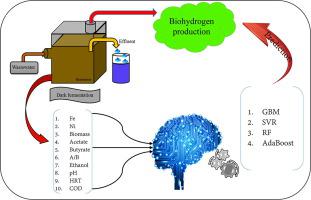Bioresource Technology ( IF 11.4 ) Pub Date : 2021-10-11 , DOI: 10.1016/j.biortech.2021.126111 Ahmad Hosseinzadeh 1 , John L Zhou 1 , Ali Altaee 1 , Donghao Li 2

|
Dark fermentation process for simultaneous wastewater treatment and H2 production is gaining attention. This study aimed to use machine learning (ML) procedures to model and analyze H2 production from wastewater during dark fermentation. Different ML procedures were assessed based on the mean squared error (MSE) and determination coefficient (R2) to select the most robust models for modeling the process. The research showed that gradient boosting machine (GBM), support vector machine (SVM), random forest (RF) and AdaBoost were the most appropriate models, which were optimized by grid search and deeply analyzed by permutation variable importance (PVI) to identify the relative importance of process variables. All four models demonstrated promising performances in predicting H2 production with high R2 values (0.893, 0.885, 0.902 and 0.889) and small MSE values (0.015, 0.015, 0.016 and 0.015). Moreover, RF-PVI demonstrated that acetate, butyrate, acetate/butyrate, ethanol, Fe and Ni were of high importance in decreasing order.
中文翻译:

污水暗发酵制氢的机器学习建模与分析
同时进行废水处理和 H 2生产的暗发酵工艺正受到关注。本研究旨在使用机器学习 (ML) 程序对暗发酵过程中废水的H 2产量进行建模和分析。根据均方误差 (MSE) 和决定系数 ( R 2) 来选择最稳健的模型来对过程进行建模。研究表明,梯度提升机 (GBM)、支持向量机 (SVM)、随机森林 (RF) 和 AdaBoost 是最合适的模型,它们通过网格搜索优化并通过排列变量重要性 (PVI) 深入分析以识别过程变量的相对重要性。所有四个模型在预测 H 2产量方面都表现出有希望的性能,具有高R 2值(0.893、0.885、0.902 和 0.889)和小 MSE 值(0.015、0.015、0.016 和 0.015)。此外,RF-PVI 证明乙酸盐、丁酸盐、乙酸盐/丁酸盐、乙醇、Fe 和 Ni 按降序排列非常重要。


























 京公网安备 11010802027423号
京公网安备 11010802027423号